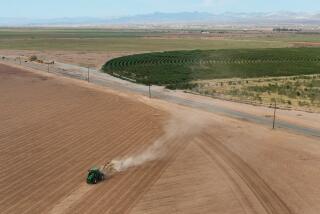La Nin~a’s Watery Birthplace: The Peruvian Pacific
- Share via
WASHINGTON — Al Dutcher, Nebraska’s state climatologist, doesn’t wish any hard luck on West Texas. Just the same, it would be a relief for Nebraska if a hurricane from the Gulf of Mexico tracked lots of rain northward into his drought-stricken state.
Dutcher’s dilemma illustrates something about the nature of climate patterns that have created the worst drought in a century or more in some areas from Nebraska into Texas and Florida.
In weather, everything is connected, and changes as far from the United States as the Pacific Ocean off Peru can wind up literally hitting home in the U.S. heartland.
The equatorial Peruvian Pacific, where ocean currents moving north from Antarctica and south from the Arctic swirl into each other, is the cradle of the La Nin~a weather pattern that’s largely responsible for the drought, Dutcher said.
La Nin~a is the weaker opposite of the El Nin~o pattern that warms surface water and brings rain.
In a La Nin~a, westward-blowing trade winds pushing across the Pacific stir cooler water from the depths. This produces below-normal surface water temperatures, which create less evaporation, resulting in drier air.
The process creates a shift in the jet stream that ordinarily carries soil-enriching rains across the U.S. Southwest into the Midwest. The change in the jet stream means the storms are more likely to be further north, from the Central Rockies into the Great Lakes.
Those rains missed much of Nebraska, Missouri and parts of Kansas, Dutcher said. Farmers who were counting on fall rains and last winter’s snow to replenish their ground water didn’t get it. Some areas did benefit from spring thunderstorms, but other areas are still dry.
The National Oceanic and Atmospheric Administration’s latest drought forecast offers hope, but only in the long term. La Nin~a should weaken over the summer, said NOAA drought specialist Douglas LeComte at the Climate Prediction Center in Camp Springs, Md. The weather system that began in the summer of 1998 “will be history by wintertime,” he said.
While the drought may ease in the extreme Southeast, the Southwest and the drought blotches of the Midwest are expected to remain dry into September--and possibly into early next year, LeComte said. And it will take time for the new rains to soak into dry ground.
The Florida-Georgia drought is as severe as conditions have been in 100 years, LeComte said. Nebraska also is in a 100-year drought. Some of Texas got the benefit of a recent rainy tropical depression, but the western edge remains as dry as the Florida-Georgia drought area.
The combination of dry air and heat as spring wears into summer will add to the soil evaporation that has left ground hard as pavement. Worse, for farmers who managed to plant, La Nin~a’s dry winter has kept the subsoil from capturing the normal reserve of water into which maturing crops extend their roots.
In the Lubbock, Texas, area, farmers got cotton planted in irrigated land or through the good fortune of some timely storms, said Randy Boman, a Texas A&M; Extension cotton agronomist. But the ground below the topsoil is dry, and this could stunt growth, he said.
Like Dutcher, Boman is mulling the good that a hurricane or two could do. “At this stage of the game, it would be a tremendous benefit to us, as long as it didn’t set on us for too many days,” he said.
Paradoxically, La Nin~a could raise the likelihood of the big storms, climate experts say. Among La Nin~a’s effects is a more favorable midlevel jet stream from Africa, where hurricanes are born. The jet stream energizes developing storms. And researchers at Florida State University, who say hurricanes have their own cycles of ebb and blow, believe the country has started a period of more frequent hurricanes.
But with weather, you have to be careful what you wish for.
Farmers in Boman’s area plant cotton capable of standing up to High Plains winds, Boman said. But a hurricane blasting through at harvest time, he added, could cost cotton farmers their crops.
More to Read
Sign up for Essential California
The most important California stories and recommendations in your inbox every morning.
You may occasionally receive promotional content from the Los Angeles Times.













